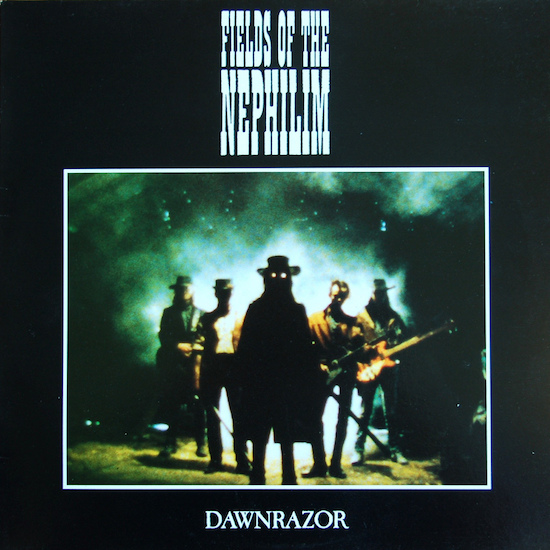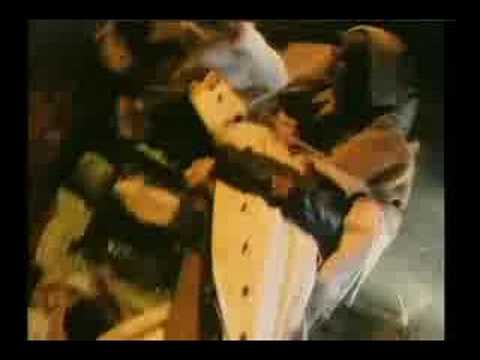If nature abhors a vacuum then rock & roll fucking loathes it.
With The Sisters Of Mercy seemingly gone for a Burton, save the rush-released Gift under the name of The Sisterhood as massive “fuck you” to The Mission who themselves, like The Cult, were busy turning themselves into over-enthusiastic rock pigs, it seemed that those living their lives in black where being ill-served. Elsewhere, The March Violets’ Simon Denbigh had formed the gloriously rocking Batfish Boys whose magnificent second album, Head, foretold goth’s move to heavier territories, while former Skeletal Family singer Anne-Marie Hurst had joined forces with erstwhile Sisters guitarist Gary Marx to form the under-rated Ghost Dance.
And yet by 1987 it seemed that Yorkshire’s dominance of all things dark had come to an end. Sure, Red Lorry Yellow Lorry could still blow up a storm but they wouldn’t be reaching a wider audience any more than say, The Rose Of Avalanche, who could never quite work out which direction to head in despite the odd flashes of brilliance here and there. Certainly, no one was expecting salvation from the most unlikely of sources – the post-war New Town of Stevenage. Or, for that matter, an influence that would both revive the genre and spill into other and unexpected areas.
Formed in 1984 by singer Carl McCoy, guitarist Peter Wright, bassist Tony Pettitt, drummer Nod Wright and saxophonist Gary Wisker, Fields Of The Nephilim released the Burning The FieldsEP the following year before replacing Wisker with second guitarist Peter Yates, and it was this point that band began to coalesce its sound and image. Indeed, to all intents and purposes, the band’s second single, ‘Power’, was by a totally different band. To listen to ‘Power’ at the remove of 31 years is to be re-acquainted with a gloriously frantic record that blends tribal beats capable of inducing the spiky chicken dance at 50 feet, twisting guitars and marvelously driven and sustained chords, and a healthy dose of sex-magick spurred on by Carl McCoy’s howling growl. Or should that be growling howl?
The whole package is a neat encapsulation of the Fields Of The Nephilim aesthetic: the French Antique/Wanted Poster typeface and the Wild West outlaw chic was brilliantly at odds with what was happening the High Streets of 80s Britain while suggesting a self-contained unit that was ready to shoot itself out of a corner like a more successful version of the climax to Butch Cassidy & The Sundance Kid. At the same time, though, with those cowboy hats, the song title’s Goudy typeface and McCoy’s throaty rumble, it was almost inevitable that comparisons to a certain band from Leeds would be made.
There were a number of crucial differences between Fields Of The Nephilim and The Sisters Of Mercy. Firstly, Fields Of The Nephilim embraced the rock idiom with the use of a real drummer. While the Sisters loudly proclaimed their rock credentials and obsession with the inherent stupidity of it with a raised and knowing eyebrow, their use of a drum machine – while undeniably vital in the creation of their own sound – prevented them from truly embracing the form. Secondly, unlike the now-defunct Sisters – Fields Of The Nephilim were a playing, touring unit whose relentless schedule and powerful live shows up and down the toilets of the country were drawing increasingly larger crowds thanks to feverish word of mouth. And it’s worth noting how important that was in age of the weekly music press, limited airplay during daytime radio and living in a backwater where a visit from a truly devastating live band could make the difference between utter boredom and a joy that could fuel your week.
Like all the best bands, Fields Of The Nephilim came across as a gang that you could not only believe in, but actually wanted to join or, in their case, saddle and up and ride with. The shoot-out logo on the back cover of those initial singles – coupled with the names McCoy/ Yates/ Wright/ Pettitt/ Wright – was an invitation to world far removed from the daily grind of the real world. This was something you could hang, yes, your hat on.
Their next single, the imperial ‘Preacher Man’, sealed the deal as it heralded the release of Dawnrazor. Three decades on since its release and the single doesn’t fail to raise the hairs on the back of the neck and elicit a Pavlovian response to hit the dance floor. Bill Buchanan’s production doesn’t skimp on the bombast – the slide guitar sounds as lacerating as ever – and the band were smart enough to utilize the film making skills of Richard Stanley. Here, in one short film, was all you needed to know: the outlaw gang imagery, post-apocalyptic wastelands mixed with spaghetti westerns and a healthy dose of horror movie imagery, It is, of course, utterly and unapologetically daft and all the better for it and in the sweaty confines of provincial goth clubs it did much to turn an average night into a great one.
But if you thought you’d caught the measure of Fields Of The Nephilim from the singles alone, then their debut album, Dawnrazor, released 30 years ago this month, held a number of surprises that at once consolidated their position of a band indulging the joys of six-string action and alternative belief systems – you really can’t beat of a bit of the occult when it comes to rock music – while pointing the way forward.
Their use of Ennio Morricone’s ‘The Harmonica Man’ from Sergio Leone’s epic 1968 spaghetti western, Once Upon A Time In The West was a fantastic nod to their imagery but also a warning of what was to come. Like the shocking moment that found cinema audiences realising in recoiled horror that the usually genial Henry Fonda was playing a character that harboured no doubts or second thoughts about slaughtering entire families, ‘The Harmonica Man’ was a warning to expect the unexpected.
And so it came to be. While the likes of ‘Slow Kill’ and the splendidly and hilariously entitled ‘Volcane (Mr Jealousy Has Returned)’ rocked with a degree of high satisfaction – the real moments that made the listener sit up and genuinely take notice where the epics ‘Vet For The Insane’ and ‘Dawnrazor’. As exemplified by The Sisters Of Mercy’s ‘Some Kind Of Stranger’ and Joy Division’s proto-goth classic ‘New Dawn Fades’, there ain’t nuthin’ better that a black-clad kid likes than an over-wrought piece of melodrama and boy, do those tracks deliver on those fronts.
What’s particularly remarkable about Fields Of The Nephilim is the quality of musical interplay at work here. Mere mention of their name will doubtlessly raise smirks and guffaws in certain circles but if you strip away the imagery and concentrate on the music then what you’re left with is music that sails into the multi-coloured waters of psychedelia. Fields Of The Nephilim know how to do drama in altered states and in their case it’s about raising the music from a whisper to a scream.
The two guitars weave in and out of each and it’s almost like a mating dance as the instruments work their way from a remove from one another to finally become a single, breathing organism. The title track in particular gives the impression of what Pink Floyd might have sounded like if they’d have paid a bit more attention to what was happening out there instead of arguing over brand names and trademarks. As far as hits from the bong were concerned, this was a smash from the first note to the last.
Taken in the context of those three albums released by that widely acknowledged classic line-up – Dawanrazor, The Nephilim (1988) and Elizium 1990 – Fields Of The Nephilim’s debut album holds up as a good album. And that’s not to damn it with faint praise. Greatness was to follow on the band’s next two releases as they simultaneously redefined the genre while transcending it. With Dawnrazor, Fields Of The Nephilim brought to a close the chapter that’s making or the breaking of any band – the moment when the set they’d been touring relentlessly was captured in the studio and presented to the world. It was up to them whether they’d go round in ever-decreasing circles or widen their brief.
Crucially, Fields Of The Nephilim would go on to score hit albums and singles at a time when rock music was being written off yet again. But with Dawnrazor this was a calling card that announced the arrival of a new sheriff in town. Notice had been served that the balance of power was shifting from one geographical region to another but, more importantly, Fields Of The Nephilim were about to show that musical growth and development within an area seemingly moribund and out of step with prevailing cultural trends was both possible and entirely achievable.
Rock & roll fucking loathed a vacuum. Fields Of The Nephilim knew how to fill it, seal it and make it totally theirs.



